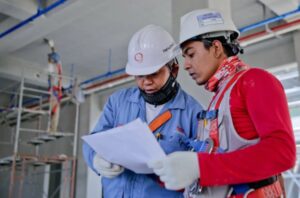Workplace safety is vital for preventing injuries, illnesses, and fatalities. Unfortunately, many workers are unaware of the potential hazards in their workplaces. Employers should take measures to ensure that workers are aware of the risks associated with their jobs and how to protect themselves.
Have you ever felt unsafe at work? Maybe they were using dangerous chemicals or equipment that might really harm you if something went wrong. Or perhaps the job was exceptionally physically demanding, and you looked like you were always in danger of suffering an injury. If any of this reminds you of your current situation, you may be working in a potentially hazardous environment. In this blog article, we’ll look at some of the most prevalent workplace risks and what you can do to stay safe. Please continue reading to learn more!
Table of Contents
ToggleElectrical Accident Hazards
Electrical accidents are one of the most prevalent workplace dangers. These can occur when workers come into contact with live electrical wires or equipment. Electrical shocks can also result from workers using not adequately connected or isolated equipment. Electrical accidents can be devastating and even fatal. Workers who are exposed to live electrical wires or equipment should always take precautions to protect themselves. It includes wearing the proper personal protective equipment and using only properly grounded and isolated electrical equipment. Employers should also hire industrial hygienists to perform regular safety audits of the workplace to identify potential electrical hazards. You must be wondering what is an industrial hygienist? An industrial hygienist uses scientific methods to identify potential threats, assess risk, or evaluate exposures in the workplace or environment while seeking safe or less harmful substitutes.
Slip, Trip, and Fall Hazards
Another common hazard in many workplaces is the risk of slip, trip, and fall accidents. These accidents can occur when workers are not paying attention to their surroundings or when they are walking on slippery or uneven surfaces. When employees climb ladders or use other equipment that isn’t adequately secured, they may fall. You can prevent slip, trip, and fall accidents by paying attention to your surroundings. Be careful when walking on slippery or uneven surfaces. Ladder safety is also vital to prevent these types of accidents.
Hazardous Materials
Many workplaces also use or store hazardous materials. These materials can include chemicals, solvents, and other dangerous substances. Hazardous materials can be harmful if inhaled, ingested, or come in contact with the skin or eyes. Workers who are exposed to hazardous materials should take precautions to protect themselves. These precautions include wearing the proper personal protective equipment and following all safety procedures when handling or using these materials. Store hazardous materials properly to prevent accidental exposures. Employees who encounter a hazardous substance should see a doctor as soon as possible. Some common hazardous materials are asbestos, benzene, lead, mercury, pesticides. If you are working with any of these materials, you should take extra care to protect yourself.
Repetitive Motion Injuries
Another hazard that is common in many workplaces is repetitive motion injuries. These injuries can occur when workers perform the same task repeatedly. They can also occur when workers use tools or equipment that vibrate. You can prevent repetitive motion injuries by taking breaks frequently, using the proper tools and equipment, and performing stretching exercises. Repeated motion injuries can also be treated by physical therapy, massage, and other methods. Some common damages caused by repetitive motion are carpal tunnel syndrome, tendonitis, and bursitis.
Noise Hazards
Noise hazards are also common in many workplaces. These hazards can occur when workers are exposed to loud noise for prolonged periods. Loud sounds cause the most frequent form of noise-induced hearing damage. Workers who are exposed to loud noise should take precautions to protect themselves. These precautions include wearing earplugs or earmuffs and avoiding exposure to loud noise when possible. Employers should also implement engineering controls to reduce noise levels in the workplace. Engineering controls are devices or systems that isolate or remove the noise source. Some standard engineering controls include sound-proofing materials, barriers, and enclosures.
Ergonomic Hazards
Ergonomic hazards are another type of hazard that you can find in many workplaces. Physical elements in the workplace that might induce musculoskeletal injuries are ergonomic risks. These hazards occur when workers are required to perform repetitive tasks or maintain awkward positions for long periods. You can prevent ergonomic hazards by using ergonomically designed tools and equipment, taking breaks frequently, and performing stretching exercises. Some common ergonomic hazards include joint and muscle strains, carpal tunnel syndrome, tendonitis, epicondylitis. Any of these injuries should be treated by a doctor as soon as possible.
Biological Hazards
Biological hazards are also present in many workplaces. These hazards can occur when workers are exposed to bacteria, viruses, and other harmful organisms. You can avoid biological hazards by taking precautions to prevent exposure, such as wearing personal protective equipment and following proper safety procedures. Some common biological hazards include hepatitis, HIV, and tuberculosis. Employers should provide workers with information about these hazards and how to protect themselves. Proper vaccination is also essential for preventing exposure to these hazards.
Radiation Hazard
Radiation hazards are also common in many workplaces. These hazards can occur when workers are exposed to radiation from X-rays, gamma rays, and other sources. To avoid any radiation-related risks, you must take precautions to prevent exposure, such as wearing personal protective equipment and following proper safety procedures. If a worker is exposed to radiation, they should visit a doctor as soon as possible. Some common injuries caused by radiation exposure are skin burns, hair loss, and cancer. Employers should provide workers with information about these hazards and how to protect themselves.
Conclusion
There are numerous health and safety risks in the workplace. You can prevent workplace hazards by taking precautions to avoid exposures. The dangers mentioned in this blog are just a few of the many risks that workers may encounter in the workplace. If you have any concerns about potential hazards at work, talk to your employer about them. Remember, proper training and education are the best ways to prevent workplace accidents and injuries. Stay safe out there, and be sure to keep these in mind the next time you’re at work. What precautions do you recommend to minimize the risks of these dangers? Let us know in the comments below!
Also Read About: Rise of Neobanks











